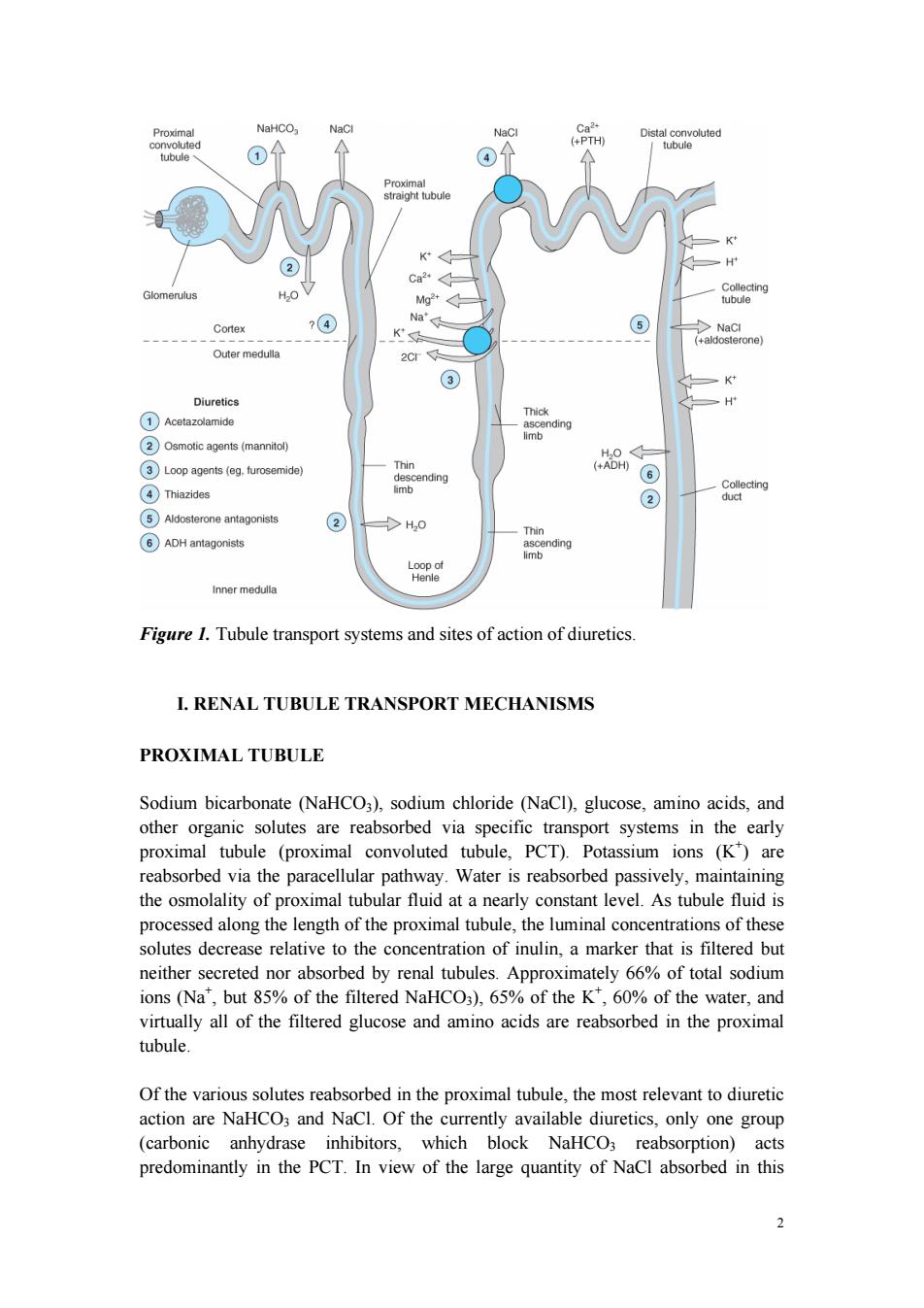正在加载图片...

Proxamal NaHCO NaCl NaCl Distal convoluted CO nvoluted (+PTH) ④ tubule tubule Proximal straight tubule K'< Glomerulus HO V Collecting Mg2 tubule Na" Cortex 74 K ⑤ NaCl (+aldosterone) Outer medulla 2Cr ③ K Diuretics H Thick (①Acetazolamide ascending 2Osmotic agents (mannitol) limb H,0< 3Loop agents (eg.furosemide) Thin (+ADH) cending ⑥ (④Thiazides limb Collecting ② duct 5Aldosterone antagonists ② >H,0 Thin ⑥ADH antagonists ascending limb Loop of Henle Inner medulla Figure I.Tubule transport systems and sites of action of diuretics. I.RENAL TUBULE TRANSPORT MECHANISMS PROXIMAL TUBULE Sodium bicarbonate (NaHCO3),sodium chloride (NaCl),glucose,amino acids,and other organic solutes are reabsorbed via specific transport systems in the early proximal tubule (proximal convoluted tubule,PCT).Potassium ions (K)are reabsorbed via the paracellular pathway.Water is reabsorbed passively,maintaining the osmolality of proximal tubular fluid at a nearly constant level.As tubule fluid is processed along the length of the proximal tubule,the luminal concentrations of these solutes decrease relative to the concentration of inulin,a marker that is filtered but neither secreted nor absorbed by renal tubules.Approximately 66%of total sodium ions (Na",but 85%of the filtered NaHCO3),65%of the K",60%of the water,and virtually all of the filtered glucose and amino acids are reabsorbed in the proximal tubule. Of the various solutes reabsorbed in the proximal tubule,the most relevant to diuretic action are NaHCO3 and NaCl.Of the currently available diuretics,only one group (carbonic anhydrase inhibitors,which block NaHCO3 reabsorption)acts predominantly in the PCT.In view of the large quantity of NaCl absorbed in this 22 Figure 1. Tubule transport systems and sites of action of diuretics. I. RENAL TUBULE TRANSPORT MECHANISMS PROXIMAL TUBULE Sodium bicarbonate (NaHCO3), sodium chloride (NaCl), glucose, amino acids, and other organic solutes are reabsorbed via specific transport systems in the early proximal tubule (proximal convoluted tubule, PCT). Potassium ions (K+ ) are reabsorbed via the paracellular pathway. Water is reabsorbed passively, maintaining the osmolality of proximal tubular fluid at a nearly constant level. As tubule fluid is processed along the length of the proximal tubule, the luminal concentrations of these solutes decrease relative to the concentration of inulin, a marker that is filtered but neither secreted nor absorbed by renal tubules. Approximately 66% of total sodium ions (Na+ , but 85% of the filtered NaHCO3), 65% of the K+ , 60% of the water, and virtually all of the filtered glucose and amino acids are reabsorbed in the proximal tubule. Of the various solutes reabsorbed in the proximal tubule, the most relevant to diuretic action are NaHCO3 and NaCl. Of the currently available diuretics, only one group (carbonic anhydrase inhibitors, which block NaHCO3 reabsorption) acts predominantly in the PCT. In view of the large quantity of NaCl absorbed in this